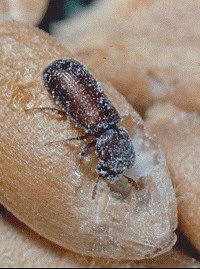Insect Pests of Stored Grain: Lesser Grain Borer
ENTFACT-137: Insect Pests of Stored Grain: Lesser Grain Borer | Download PDF
Rhyzopertha dominica (Coleoptera: Bostrichidae)
by Doug Johnson, Extension Entomologist
University of Kentucky College of Agriculture
Damage
Lesser grain borers mainly attack wheat, corn, rice and millet. Both the larvae and adults are primary pests. They bore irregularly shaped holes into whole, undamaged kernels and the larvae, immature stages, may develop inside the grain. Larval and adult feeding in and on grain kernels may leave only dust and thin brown shells. A sweet, musty odor is often associated with infestations of this insect.
Description
The adults (pictured right) are 0.1 inch long, brown to black beetles with cylindrical bodies and numerous small pits on the wing covers. The head is directed downward and covered by the prothorax so that is t is not visible when the insect is viewed from above. The creamy white larva is a c-shaped grub with a small dark head that is partly retracted into the thorax. The thorax has three pairs of small legs.
Biology
The female deposits her eggs in clusters of 2 to about 30 on kernels. Most of the newly-hatched larvae chew into kernels and complete their entire development there. However, the larvae can feed on fines or can develop as free-living insects in the grain. There are four larval stages. Development from egg to adult requires about 25 days under ideal conditions of 93 degrees F and 12% moisture. Both the larvae and adults produce a large amount of frass or waste. Larval fecal pellets are pushed out of the kernel and large amounts can accumulate in the grain. The adults are winged and may fly to spread infestations.
Control
Prevention is always the most economical and efficient method of controlling these pests. Once they are distributed within the grain mass, fumigation is the only method of relieving the problem.
For specific insecticide recommendations for individual crops see:
- Corn, Field - Insecticides for Corn, ENT-16
- Popcorn - Insecticide Recommendations for Popcorn - ENT-62
- Sorghum - Insecticide Recommendations for Sorghum (Milo) - ENT-24
- Soybeans - Insecticide Recommendations for Soybeans - ENT-13
- Wheat - Insecticide Recommendations for Small Grains - ENT-47
These publications are available at local county extension offices in Kentucky.
Issued: 8/00
Revised: 7/09
CAUTION! Pesticide recommendations in this publication are registered for use in Kentucky, USA ONLY! The use of some products may not be legal in your state or country. Please check with your local county agent or regulatory official before using any pesticide mentioned in this publication.
Of course, ALWAYS READ AND FOLLOW LABEL DIRECTIONS FOR SAFE USE OF ANY PESTICIDE!
Photo: USDA Insect and Plant Disease Slide Set

